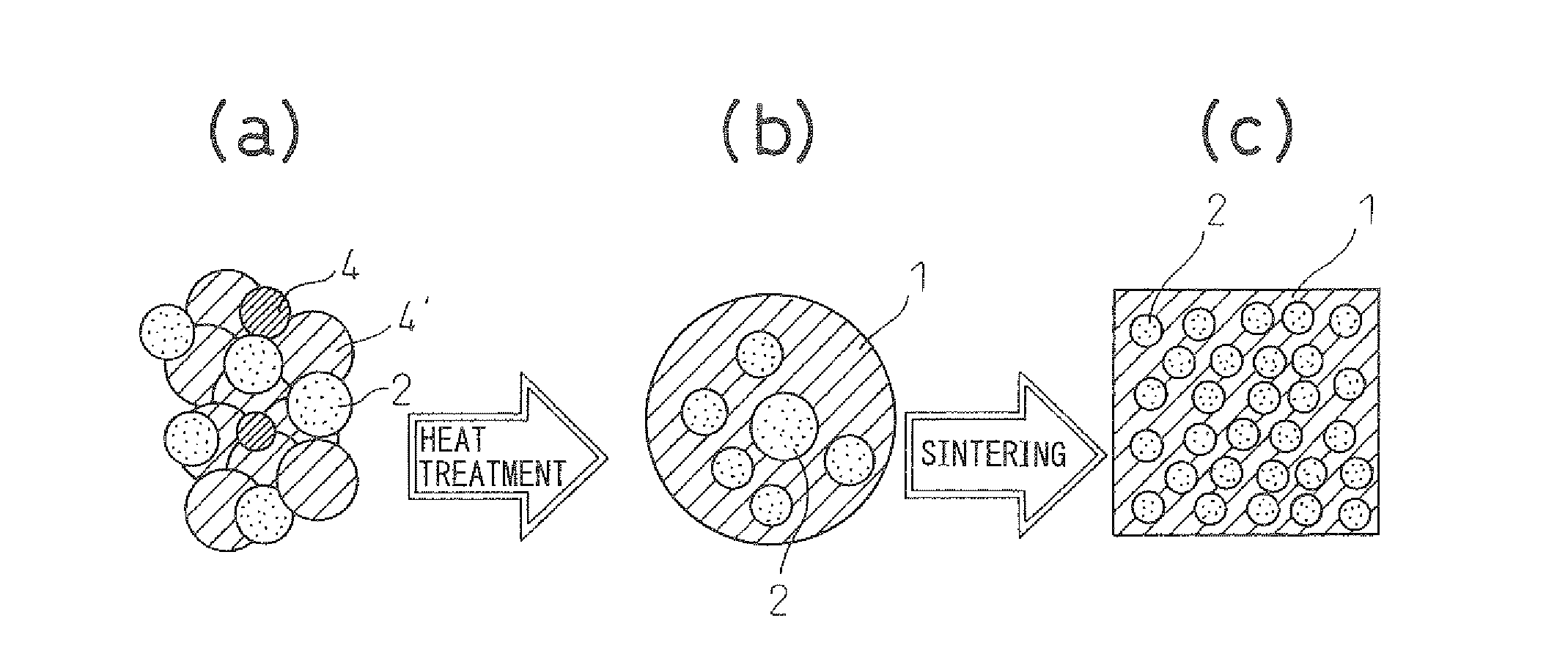Thermoelectric converter and method of manufacturing same
a technology of thermoelectric converter and manufacturing method, which is applied in the manufacture/treatment of thermoelectric devices, transportation and packaging, and thermoelectric devices. it can solve the problems of insufficient reduction of thermal conductivity, inability to disperse metals or alloys into thermoelectric conversion materials in the nanomicron order, and inability to increase the performance of thermoelectric conversion materials. it achieves the effect of increasing electrical conductivity and reducing thermal conductivity
- Summary
- Abstract
- Description
- Claims
- Application Information
AI Technical Summary
Benefits of technology
Problems solved by technology
Method used
Image
Examples
example
Example 1
[0058]2.0 g of sodium borohydride as a reducing agent was mixed in 100 mL of ethanol. On the other hand, 0.9 g of cobalt chloride, 3.6 g of antimony chloride, and 0.18 g of nickel chloride were mixed in 100 mL of ethanol, and the solution was dropped into the above sodium borohydride solution. Cobalt, antimony, and nickel particles formed thereby, were rinsed with a mixed solution of ethanol and water (mixing ratio 1:1), and impurities were removed.
[0059]The resulting slurry comprising the cobalt, antimony, and nickel was hydrothermally treated at 240° C. for 24 hours. Consequently, NiSb was deposited in the thermoelectric conversion material due to an excess amount of nickel and antimony which exceed the solid dissolution limit of the aimed thermoelectric conversion material Co0.9Ni0.1Sb3. After that, the thermoelectric converter of the present invention was obtained by SPS sintering at 500° C. The TEM image of the thermoelectric converter is shown in FIG. 5. The NiSb phas...
example 2
[0063]0.7 g of sodium borohydride as a reducing agent was mixed with 100 mL of ethanol. On the other hand, 0.8 g of nickel chloride, and 0.77 g of antimony chloride were mixed with 100 mL of ethanol, and the solution was dropped into the above sodium borohydride solution. Thus, particles of nickel antimony were produced, hydrothermally treated at 240° C. for 24 hours, and NiSb alloy particles having an average particle size of 10 to 20 nm were obtained. 0.6 g of the NiSb alloy particles were added to 100 mL of ethanol, and 1.7 g of sodium borohydride was further added.
[0064]0.9 g of cobalt chloride, 2.7 g of antimony chloride, and 0.057 g of nickel chloride were mixed with 100 mL of ethanol, and the solution was dropped into the above ethanol solution comprising NiSb alloy. Thus, particles of Co, Ni, and Sb were deposited around the NiSb alloy particles. Then, hydrothermal treatment at 240° C. for 24 hours was performed to obtain composite particles coated with the thermoelectric co...
PUM
| Property | Measurement | Unit |
|---|---|---|
| particle size | aaaaa | aaaaa |
| distance | aaaaa | aaaaa |
| distance | aaaaa | aaaaa |
Abstract
Description
Claims
Application Information
 Login to View More
Login to View More - R&D
- Intellectual Property
- Life Sciences
- Materials
- Tech Scout
- Unparalleled Data Quality
- Higher Quality Content
- 60% Fewer Hallucinations
Browse by: Latest US Patents, China's latest patents, Technical Efficacy Thesaurus, Application Domain, Technology Topic, Popular Technical Reports.
© 2025 PatSnap. All rights reserved.Legal|Privacy policy|Modern Slavery Act Transparency Statement|Sitemap|About US| Contact US: help@patsnap.com



